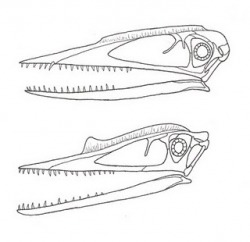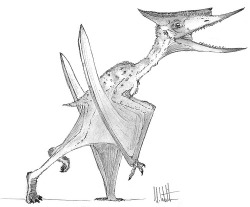Introduction
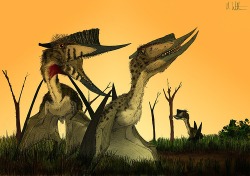
Pterosaurs, as a group, do need a lot of study, but I feel that there's not enough places in the internet in which there is a page dedicated to Dsungaripteroidea, one of the clades of pterosaurs I find the most bizarre (on the left another pic by Mark Witton, featuring the famous Dsungaripterus). While two of the members of this clade, Dsungaripterus itself and Germanodactylus, are quite well known, not much seems to be elaborated on them, and in fact most people probably have the idea that they are just "regular pterosaurs", aka seabird analogues (with Dsungaripterus having specialasations for mollusc eating, but otherwise just being a weird seagull). As you may know, I despise when people think pterosaurs were seabird analogues, and dsungaripteroids were nothing like seagulls, meaning this stereotype is stupid.
Once again, I decided to make justice and present the most accurate information on these animals.
Once again, I decided to make justice and present the most accurate information on these animals.
Phylogeny and Taxa
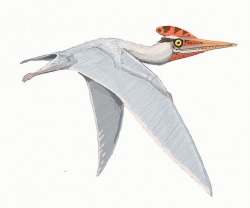
Dsungaripteroidea, when it comes to its genera, is quite confusing. As of yet it is only sure that there are derived dsungaripteroids (under Dsungaripteridae) and a menagerie of basal forms; it seems, its still undecided whereas some of the "basal taxa" should be classified alongside the more derived ones (to the left, Germanodactylus as presented by Dmitri Bognadov; this genus seems to have been recently included within Dsungaripteridae, but of course it may again join the more basal taxa eventually). About 6 genera are recognised within Dsungaripteridae, should Germanodactylus be within that clade, and 4 genera recongnised as basal dsungaripteroids. Notably, two taxa, Herbstosaurus and Tendaguripterus, may not be dsungaripteroids at all; the same may apply to Puntanipterus, considered often a dsungaripterid, but that may instead be related to the ctenochasmatoid Pterodaustro.
On the great scheme of pterosaur phylogeny, the exact placement of Dsungaripteroidea is controversial, but it is generally agreed that they are related to azhdarchoids (the main controversy being on whereas ornithocheiroids are closer to azhdarchoids or not, though they are often considered the most basal pterodactyloids instead). Indeed, both dsungaripterids and azhdarchoids share several characteristics, having both specialised towards terrestrial lifestyles, such as long metacarpals and pelvic features to allow better terrestrial locomotion; however, most of these features are only present in the most derived dsungaripterids, meaning that its the result of convergence rather than a proof of common ancestry, and basal dsungaripteroids (including the potential dsungaripterid Germanodactylus) resemble more "generic" pterodactyls, specially basal ctenochasmatoids like Pterodactylus.
Its worth to note that basal dsungaripteroids, up to Germanodactylus, have a skull quite similar to the intermediate pterosaur Darwinopterus; this may mean that forms like Tendaguripterus may in fact be relatives of Darwinopterus. Its also worth to say that the pterosaur "missing link", while claimed to be an aerial predator, hasn't its lifestyle well studied, and may indeed have had a similar diet to that of early dsungaripterids...or not.
On the great scheme of pterosaur phylogeny, the exact placement of Dsungaripteroidea is controversial, but it is generally agreed that they are related to azhdarchoids (the main controversy being on whereas ornithocheiroids are closer to azhdarchoids or not, though they are often considered the most basal pterodactyloids instead). Indeed, both dsungaripterids and azhdarchoids share several characteristics, having both specialised towards terrestrial lifestyles, such as long metacarpals and pelvic features to allow better terrestrial locomotion; however, most of these features are only present in the most derived dsungaripterids, meaning that its the result of convergence rather than a proof of common ancestry, and basal dsungaripteroids (including the potential dsungaripterid Germanodactylus) resemble more "generic" pterodactyls, specially basal ctenochasmatoids like Pterodactylus.
Its worth to note that basal dsungaripteroids, up to Germanodactylus, have a skull quite similar to the intermediate pterosaur Darwinopterus; this may mean that forms like Tendaguripterus may in fact be relatives of Darwinopterus. Its also worth to say that the pterosaur "missing link", while claimed to be an aerial predator, hasn't its lifestyle well studied, and may indeed have had a similar diet to that of early dsungaripterids...or not.
The skull of Germanodactylus compared with that of Darwinopterus; courtesy of Zachary Miller.
Anatomy and lifestyle
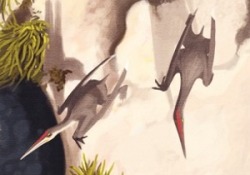
Basal or "conservative" dsungaripteroids, like Germanodactylus, weren't very different from other "generic" pterodactyloids like Pterodactylus, and therefore weren't very specialised (to the left, a picture of Germanodactylus as done by John Conway; note the hindlimbs free of the patagium, something that John Conway forgot to correct as he did with other of his pterosaur pictures). These animals almost certainly searched for food in the ground, using the toothed rostrum to seize snails, large arthropods and perhaps small mammals and reptiles; in an ecosystem like the islands that would one day become Solnhofën, an animal like Germanodactylus would have searched for food inland like modern insular rails, while other pterodactyloids waded or swimmed along the shores.
As dsungaripteroids evolved, they became more and more specialised to search for food on the ground, and, according to those that interpret the diet of these animals as shellfish/crustacean biased (see below), more specialised in feeding on hard shelled invertebrates. Ence, we have the apex of the evolution of dsungaripteroids, robust animals like Dsungaripterus and Noripterus, animals that were as far as the pterosaur body plan could get from the delicate looking azhdarchoids and ornithocheiroids. Most people have the erroneous idea dsungaripteroids were just weird seabird pterosaurs, but I personaly can honestly only compare them to winged boars, for various reasons.
Picture of Dsungaripterus (but more similar to Noripterus) by Mark Witton; note the forelimb proportions, similar to those of azhdarchids, but with a longer wing finger.
As mentioned before, dsungaripterids were very terrestrial in habits. Their fossils come from inland deposits, far from marine environments, and their skeleton has adapted to terrestrial locomotion. Besides the aforementioned front limb proportions and pelvic and hindlimb adaptations, they also have a ridiculously robust skeleton; their bones have thick walls, as opposed to the very thin walls of ornithocheiroids and azhdarchoids (specially derived forms like azhdarchids), suggesting these animals certainly didn't soar seabird style as they do on stupid old pictures; rather, these animals most likely only took off when really pressure to, like modern galliformes; while their wing fingers are longer than those of azhdarchoids, this doesn't mean they were better fliers, most likely only having longer wings in order to compensate for their robust skeleton, and their flight style wouldn't have been very different from that of modern ground dweeling birds, flapping their wings powerfully and gliding down once they achieved enough height and distance. Certainly, they would had been very reluctant and clumsy fliers, and it would had been unlikely that these creatures made long migrations, though they were still competent fliers to spread across several landmasses (see below). Most likely they would have produced flightless forms if they had lived longer.
When people suggest dsungaripteroids were shellfish/crustacean eaters, they have good reasons to, since they do show adaptations that could be interpreted for this kind of diet. While basal dsungaripteroids had a normal pterosaur dentition, the dsungaripterids had long, toothless beaks at the tip of their jaws, with the teeth having moved more towards the back of the jaws and having turned more rounded, short and thick; in Dsungaripterus itself they fused with the jaw bone. Many species show a gap between the lower jaw and the upper jaw at the toothless beak, allowing a more efficient grabbing action; the upper jaw sans the beak became deeper, and the jaws became less pneumatized (ence why probably they had a deep nasoanteorbital frenestra, to make the skull still relatively light). All in all, these animals were the pterosaurs that were more competent at probing, grabbing and crushing hard shelled prey.
However, I personaly don't think that dsungaripterids were specialised totally to prey on shellfish and crabs; for one, their lack of fossils in coastoal environments and their adaptations to terrestriality. Being clearly sedentary as they were, and because the changes they made to their skull would also be usefull to feed on other prey items, one would think they would explore other food sources too. Their jaws are perfect to grab and kill small vertebrates like mammals and lepidosaurs, and they could very well had searched for prey in the forest undergrowth much like modern pigs do, probing with their toothless beaked jaw tips, guided by touch instead of smell. They could also probably scavenge, using their beaks to rip off flesh and their teeth to break small bones; its also not hard to imagine a dsungaripteroid killing a similar sized dinosaur or pterosaur, specially with jaws like that. Overall, I suppose these were the hogs of the early Cretaceous.
Also note that more than one genus seems to occur at a specific area, like in the case of Dsungaripterus and Noripterus; most likely this indicates that these pteerosaurs were quite diverse in the niches they occupied.
As mentioned before, dsungaripterids were very terrestrial in habits. Their fossils come from inland deposits, far from marine environments, and their skeleton has adapted to terrestrial locomotion. Besides the aforementioned front limb proportions and pelvic and hindlimb adaptations, they also have a ridiculously robust skeleton; their bones have thick walls, as opposed to the very thin walls of ornithocheiroids and azhdarchoids (specially derived forms like azhdarchids), suggesting these animals certainly didn't soar seabird style as they do on stupid old pictures; rather, these animals most likely only took off when really pressure to, like modern galliformes; while their wing fingers are longer than those of azhdarchoids, this doesn't mean they were better fliers, most likely only having longer wings in order to compensate for their robust skeleton, and their flight style wouldn't have been very different from that of modern ground dweeling birds, flapping their wings powerfully and gliding down once they achieved enough height and distance. Certainly, they would had been very reluctant and clumsy fliers, and it would had been unlikely that these creatures made long migrations, though they were still competent fliers to spread across several landmasses (see below). Most likely they would have produced flightless forms if they had lived longer.
When people suggest dsungaripteroids were shellfish/crustacean eaters, they have good reasons to, since they do show adaptations that could be interpreted for this kind of diet. While basal dsungaripteroids had a normal pterosaur dentition, the dsungaripterids had long, toothless beaks at the tip of their jaws, with the teeth having moved more towards the back of the jaws and having turned more rounded, short and thick; in Dsungaripterus itself they fused with the jaw bone. Many species show a gap between the lower jaw and the upper jaw at the toothless beak, allowing a more efficient grabbing action; the upper jaw sans the beak became deeper, and the jaws became less pneumatized (ence why probably they had a deep nasoanteorbital frenestra, to make the skull still relatively light). All in all, these animals were the pterosaurs that were more competent at probing, grabbing and crushing hard shelled prey.
However, I personaly don't think that dsungaripterids were specialised totally to prey on shellfish and crabs; for one, their lack of fossils in coastoal environments and their adaptations to terrestriality. Being clearly sedentary as they were, and because the changes they made to their skull would also be usefull to feed on other prey items, one would think they would explore other food sources too. Their jaws are perfect to grab and kill small vertebrates like mammals and lepidosaurs, and they could very well had searched for prey in the forest undergrowth much like modern pigs do, probing with their toothless beaked jaw tips, guided by touch instead of smell. They could also probably scavenge, using their beaks to rip off flesh and their teeth to break small bones; its also not hard to imagine a dsungaripteroid killing a similar sized dinosaur or pterosaur, specially with jaws like that. Overall, I suppose these were the hogs of the early Cretaceous.
Also note that more than one genus seems to occur at a specific area, like in the case of Dsungaripterus and Noripterus; most likely this indicates that these pteerosaurs were quite diverse in the niches they occupied.
Rise and demise
Dsungaripteroids seem to have evolved in the late Jurassic, soon after the first pterodactyloids appear in thee fossil record, suggesting that they began diversifying very early and very quickly; by the Albian, they seem to have reached a quite wide range, with fossils coming from both Asia and South America (no dsungaripterid fossils occur in Europe [sans maybe Germanodactylus], North America or Africa, though several basal dsungaripteroids occur in these locations; this could either mean Asia and South America had faunal interchanges via the relatively more fossil poor Africa, or that dsungaripterids were cosmopolitian and we just happened to not find any in the other continents).
Dsungaripterids seem to have vanished by the end of the Early Cretaceous, something that also happened to other pterosaur clades; while this may be due to gaps in the fossil record, they were defenitely absent in the northern hemisphere by the Turonian. Afterwards, their ecological niche was occupied in Laurasian landmasses by the oviraptors, another linage of omnivores biased towards molluscivory. Its hard to imagine why these animals suddenly disappeared; most likely the extinctions that took place between the late Early Cretaceous up to the Turonian efficiently eliminated them from the northern hemisphere.
However, the fossil record in the southern hemisphere is very poor in the southern hemisphere; only South America retains a decent fossil record of terrestrial ecosystems after the Turonian. Considering there's no fossils from Africa and Australia, maybe dsungaripterids might have survived longer around there, although this is of course a speculation.
Dsungaripterids seem to have vanished by the end of the Early Cretaceous, something that also happened to other pterosaur clades; while this may be due to gaps in the fossil record, they were defenitely absent in the northern hemisphere by the Turonian. Afterwards, their ecological niche was occupied in Laurasian landmasses by the oviraptors, another linage of omnivores biased towards molluscivory. Its hard to imagine why these animals suddenly disappeared; most likely the extinctions that took place between the late Early Cretaceous up to the Turonian efficiently eliminated them from the northern hemisphere.
However, the fossil record in the southern hemisphere is very poor in the southern hemisphere; only South America retains a decent fossil record of terrestrial ecosystems after the Turonian. Considering there's no fossils from Africa and Australia, maybe dsungaripterids might have survived longer around there, although this is of course a speculation.
